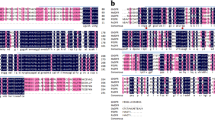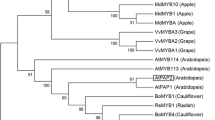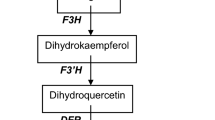Abstract
Key message
This study developed a new purple coloured Taraxacum brevicorniculatum plant through genetic transformation using the Arabidopsis AtPAP1 gene, which overproduced anthocyanins in its vegetative tissues.
Abstract
Rubber-producing Taraxacum plants synthesise high-quality natural rubber (NR) in their roots and so are a promising alternative global source of this raw material. A major factor in its commercialization is the need for multipurpose exploitation of the whole plant. To add value to the aerial tissues, red/purple plants of the rubber-producing Taraxacum brevicorniculatum species were developed through heterologous expression of the production of anthocyanin pigment 1 (AtPAP1) transcription factor from Arabidopsis thaliana. The vegetative tissue of the transgenic plants showed an average of a 48-fold increase in total anthocyanin content over control levels, but with the exception of pigmentation, the transgenic plants were phenotypically comparable to controls and displayed similar growth vigor. Southern blot analysis confirmed that the AtPAP1 gene had been integrated into the genome of the high anthocyanin Taraxacum plants. The AtPAP1 expression levels were estimated by quantitative real-time PCR and were highly correlated with the levels of total anthocyanins in five independent transgenic lines. High levels of three cyanidin glycosides found in the purple plants were characterized by high performance liquid chromatography–mass spectrum analysis. The presence of NR was verified by NMR and infrared spectroscopy, and confirmed that NR biosynthesis had not been affected in the transgenic Taraxacum lines. In addition, other major phenylpropanoid products such as chlorogenic acid and quercetin glycosides were also enhanced in the transgenic Taraxacum. The red/purple transgenic Taraxacum lines described in this study would increase the future application of the species as a rubber-producing crop due to its additional health benefits.







Similar content being viewed by others
Abbreviations
- MS:
-
Murashige and Skoog medium
- HPLC:
-
High performance liquid chromatography
- HPLC–MS:
-
High performance liquid chromatography–mass spectrum
- NMR:
-
Nuclear magnetic resonance
- GUS:
-
β-Glucuronidasegene
- CPT:
-
Cis-prenyltransferase
- SRPP:
-
Small rubber particle protein
- PAL:
-
Phenylalanine ammonia lyase
- C4H:
-
Cinnamate 4-monooxygenase
- C3H:
-
Coumarate 3-hydroxylase
- CHS:
-
Chalcone synthase
- CHI:
-
Chalcone isomerase
- F3H:
-
Flavanone 3-hydroxylase
- CaMV 35S:
-
Cauliflower mosaic virus 35S promoter
References
Brunetti C, Di Ferdinando M, Fini A, Pollastri S, Tattini M (2013) Flavonoids as antioxidants and developmental regulators: relative significance in plants and humans. Int J Mol Sci 14:3540–3555
Buer CS, Imin N, Djordjevic MA (2010) Flavonoids: new roles for old molecules. J Integr Plant Biol 52(1):98–111
Buranov AU, Elmuradov BJ (2010) Extraction and characterization of latex and natural rubber from rubber-bearing plants. J Agric Food Chem 58:734–743
Butelli E, Titta L, Giorgio M, Mock HP, Matros A, Peterek S, Schijlen EG, Hall RD, Bovy AG, Luo J, Martin C (2008) Enrichment of tomato fruit with health-promoting anthocyanins by expression of select transcription factors. Nat Biotechnol 26:1301–1308
Clarke JD (2009) Cetyltrimethyl ammonium bromide (CTAB) DNA miniprep for plant DNA isolation. Cold Spring Harb Protoc. doi:10.1101/pdb.prot5177
Collins-Silva J, Nural AT, Skaggs A, Scott D, Hathwaik U, Woolsey R, Schegg K, McMahan C, Whalen M, Cornish K, Shintani D (2012) Altered levels of the Taraxacum kok-saghyz (Russian dandelion) small rubber particle protein, TkSRPP3, result in qualitative and quantitative changes in rubber metabolism. Phytochemistry 79:46–56
Dixon RA, Liu C, Jun JH (2013) Metabolic engineering of anthocyanins and condensed tannins in plants. Curr Opin Biotechnol 24:329–335
Elomaa P, Uimari A, Mehto M, Albert VA, Laitinen RA, Teeri TH (2003) Activation of anthocyanin biosynthesis in Gerbera hybrida (Asteraceae) suggests conserved protein–protein and protein-promoter interactions between the anciently diverged monocots and eudicots. Plant Physiol 133:1831–1842
Espley RV, Hellens RP, Putterill J, Stevenson DE, Kutty-Amma S, Allan AC (2007) Red colouration in apple fruit is due to the activity of the MYB transcription factor, MdMYB10. Plant J 49:414–427
Feller A, Machemer K, Braun EL, Grotewold E (2011) Evolutionary and comparative analysis of MYB and bHLH plant transcription factors. Plant J 66:94–116
Grotewold E (2006) The genetics and biochemistry of floral pigments. Annu Rev Plant Biol 57:761–780
Hillebrand A, Post JJ, Wurbs D, Wahler D, Lenders M, Krzyzanek V, Prufer D, Gronover CS (2012) Down-regulation of small rubber particle protein expression affects integrity of rubber particles and rubber content in Taraxacum Brevicorniculatum. PLoS One. doi:10.1371/journal.pone.0041874
Kirschner J, Štěpánek J, Černý T, Peter DH, Peter J, Dijk van (2013) Available exsitu germplasm of the potential rubber crop Taraxacum Koksaghyz belongs to a poor rubber producer, T. Brevicorniculatum (Compositae–Crepidinae). Genet Resour Crop Ev 60:455–471
Koes R, Verweij W, Quattrocchio F (2005) Flavonoids: a colorful model for the regulation and evolution of biochemical pathways. Trends Plant Sci 10:236–242
Krotkov G (1945) A review of literature on Taraxacum kok-saghyz. Rod Bot Rev 11:417–461
Kuhn BM, Geisler M, Bigler L, Ringli C (2011) Flavonols accumulate asymmetrically and affect auxin transport in Arabidopsis. Plant Physiol 156:585–595
Laitinen RA, Ainasoja M, Broholm SK, Teeri TH, Elomaa P (2008) Identification of target genes for a MYB-type anthocyanin regulator in Gerbera hybrida. J Exp Bot 59:3691–3703
Lepiniec L, Debeaujon I, Routaboul JM, Baudry A, Pourcel L, Nesi N, Caboche M (2006) Genetics and biochemistry of seed flavonoids. Annu Rev Plant Biol 57:405–430
Li H, Flachowsky H, Fischer TC, Hanke MV, Forkmann G, Treutter D, Schwab W, Hoffmann TS, Zankowski I (2007) Maize Lc Transcription Factor enhances biosynthesis of anthocyanins, distinct proanthocyanidins and phenylpropanoids in apple (Malus Domestica Borkh.). Planta 226:1243–1254
Li X, Gao MJ, Pan HY, Cui DJ, Gruber MY (2010) Purple canola: Arabidopsis PAP1 increases antioxidants and phenolics in Brassica napus leaves. J Agric Food Chem 58:1639–1645
Li X, Ma H, Huang H, Li D, Yao S (2013) Natural anthocyanins from phytoresources and their chemical researches. Nat Prod Res 27:456–469
Munt O, Arias M, Hernandez M, Ritter E, Gronover CS, Prüfera D (2012) Fertilizer and planting strategies to increase biomass and improve root morphology in the natural rubber producer taraxacum brevicorniculatum. Ind Crops Prod 36:289–293
Paz-Ares J, Ghosal D, Wienand U, Peterson PA, Saedler H (1987) The regulatory c1 locus of Zea mays encodes a protein with homology to myb proto-oncogene products and with structural similarities to transcriptional activators. EMBO J 6:3553–3558
Petroni K, Tonelli C (2011) Recent advances on the regulation of anthocyanin synthesis in reproductive organs. Plant Sci 181:219–229
Post J, van Deenen N, Fricke J, Kowalski N, Wurbs D, Schaller H, Eisenreich W, Huber C, Twyman RM, Prufer D, Gronover CS (2012) Laticifer-specific cis-prenyltransferase silencing affects the rubber, triterpene, and inulin content of Taraxacum Brevicorniculatum. Plant Physiol 158:1406–1417
Qiu J, Gao F, Shen G, Li C, Han X, Zhao Q, Zhao D, Hua X, Pang Y (2013) Metabolic engineering of the phenylpropanoid pathway enhances the antioxidant capacity of Saussurea involucrata. PLoS One. doi:10.1371/journal.pone.0070665
Quattrocchio FM (1994) Regulatory genes controlling flower pigmentation in petunia hybrida. PhD thesis, Vrije University, Netherlands
Rowan DD, Cao M, Lin-Wang K, Cooney JM, Jensen DJ, Austin PT, Hunt MB, Norling C, Hellens RP, Schaffer RJ, Allan AC (2009) Environmental regulation of leaf colour in red 35S:PAP1 Arabidopsis thaliana. New Phytol 182:102–115
Schmidt T, Lenders M, Hillebrand A, van Deenen N, Munt O, Reichelt R, Eisenreich W, Fischer R, Prufer D, Gronover CS (2010) Characterization of rubber particles and rubber chain elongation in Taraxacum koksaghyz. BMC Biochem. doi:10.1186/1471-2091-11-11
Schutz K, Carle R, Schieber A (2006) Taraxacum—a review on its phytochemical and pharmacological profile. J Ethnopharmacol 107:313–323
Suchat S, Pioch D, Palu S, Tardan E, Loo ENv, Davrieux F (2013) Fast determination of the resin and rubber content in Parthenium argentatum biomass using near infrared spectroscopy. Ind Crops Prod 45:44–51
van Beilen JB, Poirier Y (2007a) Establishment of new crops for the production of natural rubber. Trends Biotechnol 25:522–529
van Beilen JB, Poirier Y (2007b) Guayule and Russian dandelion as alternative sources of natural rubber. Crit Rev Biotechnol 27:217–231
Wahler D, Gronover CS, Richter C, Foucu F, Twyman RM, Moerschbacher BM, Fischer R, Muth J, Prufer D (2009) Polyphenoloxidase silencing affects latex coagulation in Taraxacum Species. Plant Physiol 151:334–346
Whaley WG, Bowen JS (1947) Russian Dandelion (kok-saghyz). An emergency source of natural rubber. USDA Miscellaneous Publication 618, Washington, DC
Zhao J, Li ZT, Chen J, Henny RJ, Gray DJ, Chen J (2013) Purple-leaved Ficus lyrata plants produced by overexpressing a grapevine VvMybA1 gene. Plant Cell Rep 32:1783–1793
Zhou LL, Zeng HN, Shi MZ, Xie DY (2008) Development of tobacco callus cultures over expressing Arabidopsis PAP1/MYB75 transcription factor and characterization of anthocyanin biosynthesis. Planta 229:37–51
Zuluaga DL, Gonzali S, Loreti E, Pucciariello C, Degl’Innocenti ED, Guidi L, Alpi A, Perata P (2008) Arabidopsis thaliana MYB75/PAP1 transcription factor induces anthocyanin production in transgenic tomato plants. Funct Plant Biol 35:606–618
Acknowledgments
This work was supported by the Earmarked Fund for Modern Agro-industry Technology Research System (CARS-34) and the Shandong Linglong Tyre Company Limited.
Author information
Authors and Affiliations
Corresponding author
Additional information
Communicated by A. Dhingra.
Rights and permissions
About this article
Cite this article
Qiu, J., Sun, S., Luo, S. et al. Arabidopsis AtPAP1 transcription factor induces anthocyanin production in transgenic Taraxacum brevicorniculatum . Plant Cell Rep 33, 669–680 (2014). https://doi.org/10.1007/s00299-014-1585-8
Received:
Revised:
Accepted:
Published:
Issue Date:
DOI: https://doi.org/10.1007/s00299-014-1585-8




